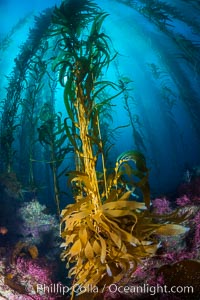
Kelp holdfast attaches the plant to the rocky reef on the oceans bottom. Kelp blades are visible above the holdfast, swaying in the current.
Location: Catalina Island, California
Image ID: 34211
Location: Catalina Island, California
Image ID: 34211
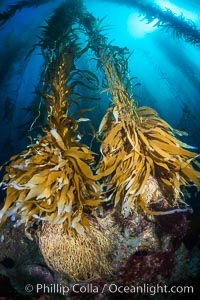
Kelp holdfast attaches the plant to the rocky reef on the oceans bottom. Kelp blades are visible above the holdfast, swaying in the current.
Species: Catalina island
Location: California
Image ID: 34213
Species: Catalina island
Location: California
Image ID: 34213
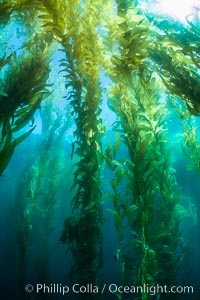
Sunlight streams through giant kelp forest. Giant kelp, the fastest growing plant on Earth, reaches from the rocky reef to the ocean's surface like a submarine forest.
Location: Catalina Island, California
Image ID: 34215
Location: Catalina Island, California
Image ID: 34215
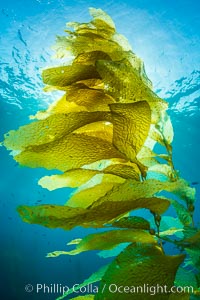
Sunlight streams through giant kelp forest. Giant kelp, the fastest growing plant on Earth, reaches from the rocky reef to the ocean's surface like a submarine forest.
Location: Catalina Island, California
Image ID: 34227
Location: Catalina Island, California
Image ID: 34227
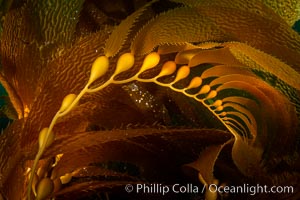
Kelp fronds and pneumatocysts. Pneumatocysts, gas-filled bladders, float the kelp plant off the ocean bottom toward the surface and sunlight, where the leaf-like blades and stipes of the kelp plant grow fastest. Giant kelp can grow up to 2' in a single day given optimal conditions. Epic submarine forests of kelp grow throughout California's Southern Channel Islands.
Species: Giant kelp, Macrocystis pyrifera
Location: San Clemente Island, California
Image ID: 34599
Species: Giant kelp, Macrocystis pyrifera
Location: San Clemente Island, California
Image ID: 34599
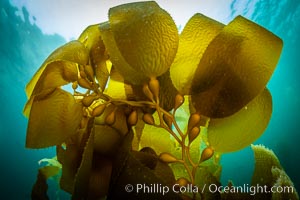
Kelp fronds and pneumatocysts. Pneumatocysts, gas-filled bladders, float the kelp plant off the ocean bottom toward the surface and sunlight, where the leaf-like blades and stipes of the kelp plant grow fastest. Giant kelp can grow up to 2' in a single day given optimal conditions. Epic submarine forests of kelp grow throughout California's Southern Channel Islands.
Species: Giant kelp, Macrocystis pyrifera
Location: San Clemente Island, California
Image ID: 34600
Species: Giant kelp, Macrocystis pyrifera
Location: San Clemente Island, California
Image ID: 34600
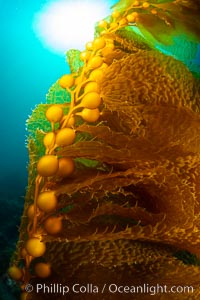
Kelp fronds and pneumatocysts. Pneumatocysts, gas-filled bladders, float the kelp plant off the ocean bottom toward the surface and sunlight, where the leaf-like blades and stipes of the kelp plant grow fastest. Giant kelp can grow up to 2' in a single day given optimal conditions. Epic submarine forests of kelp grow throughout California's Southern Channel Islands.
Species: Giant kelp, Macrocystis pyrifera
Location: San Clemente Island, California
Image ID: 34601
Species: Giant kelp, Macrocystis pyrifera
Location: San Clemente Island, California
Image ID: 34601
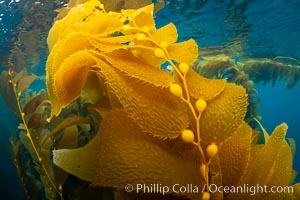
Kelp fronds and pneumatocysts. Pneumatocysts, gas-filled bladders, float the kelp plant off the ocean bottom toward the surface and sunlight, where the leaf-like blades and stipes of the kelp plant grow fastest. Giant kelp can grow up to 2' in a single day given optimal conditions. Epic submarine forests of kelp grow throughout California's Southern Channel Islands.
Species: Giant kelp, Macrocystis pyrifera
Location: San Clemente Island, California
Image ID: 34602
Species: Giant kelp, Macrocystis pyrifera
Location: San Clemente Island, California
Image ID: 34602
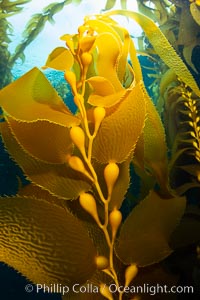
Kelp fronds and pneumatocysts. Pneumatocysts, gas-filled bladders, float the kelp plant off the ocean bottom toward the surface and sunlight, where the leaf-like blades and stipes of the kelp plant grow fastest. Giant kelp can grow up to 2' in a single day given optimal conditions. Epic submarine forests of kelp grow throughout California's Southern Channel Islands.
Species: Giant kelp, Macrocystis pyrifera
Location: San Clemente Island, California
Image ID: 34603
Species: Giant kelp, Macrocystis pyrifera
Location: San Clemente Island, California
Image ID: 34603
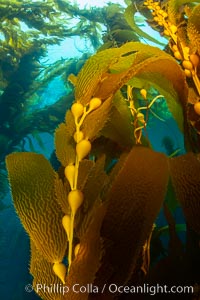
Kelp fronds and pneumatocysts. Pneumatocysts, gas-filled bladders, float the kelp plant off the ocean bottom toward the surface and sunlight, where the leaf-like blades and stipes of the kelp plant grow fastest. Giant kelp can grow up to 2' in a single day given optimal conditions. Epic submarine forests of kelp grow throughout California's Southern Channel Islands.
Species: Giant kelp, Macrocystis pyrifera
Location: San Clemente Island, California
Image ID: 34604
Species: Giant kelp, Macrocystis pyrifera
Location: San Clemente Island, California
Image ID: 34604
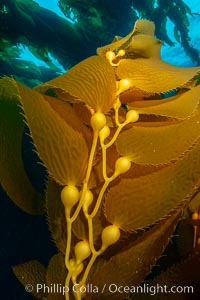
Kelp fronds and pneumatocysts. Pneumatocysts, gas-filled bladders, float the kelp plant off the ocean bottom toward the surface and sunlight, where the leaf-like blades and stipes of the kelp plant grow fastest. Giant kelp can grow up to 2' in a single day given optimal conditions. Epic submarine forests of kelp grow throughout California's Southern Channel Islands.
Species: Giant kelp, Macrocystis pyrifera
Location: San Clemente Island, California
Image ID: 34605
Species: Giant kelp, Macrocystis pyrifera
Location: San Clemente Island, California
Image ID: 34605
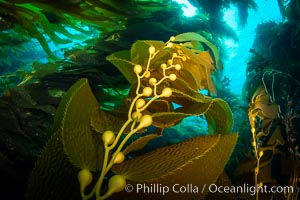
Kelp fronds and pneumatocysts. Pneumatocysts, gas-filled bladders, float the kelp plant off the ocean bottom toward the surface and sunlight, where the leaf-like blades and stipes of the kelp plant grow fastest. Giant kelp can grow up to 2' in a single day given optimal conditions. Epic submarine forests of kelp grow throughout California's Southern Channel Islands.
Species: Giant kelp, Macrocystis pyrifera
Location: San Clemente Island, California
Image ID: 34606
Species: Giant kelp, Macrocystis pyrifera
Location: San Clemente Island, California
Image ID: 34606
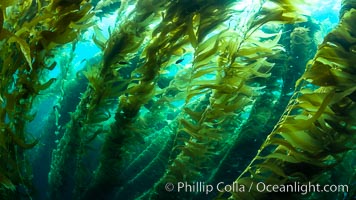
The Kelp Forest of San Clemente Island, California. A kelp forest. Giant kelp grows rapidly, up to 2' per day, from the rocky reef on the ocean bottom to which it is anchored, toward the ocean surface where it spreads to form a thick canopy. Myriad species of fishes, mammals and invertebrates form a rich community in the kelp forest. Lush forests of kelp are found throughout California's Southern Channel Islands.
Species: Giant kelp, Macrocystis pyrifera
Location: San Clemente Island, California
Image ID: 34609
Species: Giant kelp, Macrocystis pyrifera
Location: San Clemente Island, California
Image ID: 34609
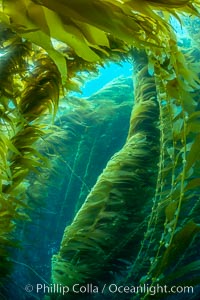
The Kelp Forest of San Clemente Island, California. A kelp forest. Giant kelp grows rapidly, up to 2' per day, from the rocky reef on the ocean bottom to which it is anchored, toward the ocean surface where it spreads to form a thick canopy. Myriad species of fishes, mammals and invertebrates form a rich community in the kelp forest. Lush forests of kelp are found throughout California's Southern Channel Islands.
Species: Giant kelp, Macrocystis pyrifera
Location: San Clemente Island, California
Image ID: 34610
Species: Giant kelp, Macrocystis pyrifera
Location: San Clemente Island, California
Image ID: 34610
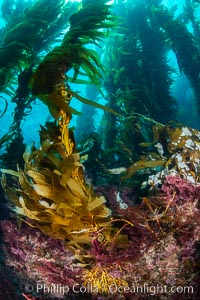
The Kelp Forest of San Clemente Island, California. A kelp forest. Giant kelp grows rapidly, up to 2' per day, from the rocky reef on the ocean bottom to which it is anchored, toward the ocean surface where it spreads to form a thick canopy. Myriad species of fishes, mammals and invertebrates form a rich community in the kelp forest. Lush forests of kelp are found throughout California's Southern Channel Islands.
Species: Giant kelp, Macrocystis pyrifera
Location: San Clemente Island, California
Image ID: 34611
Species: Giant kelp, Macrocystis pyrifera
Location: San Clemente Island, California
Image ID: 34611
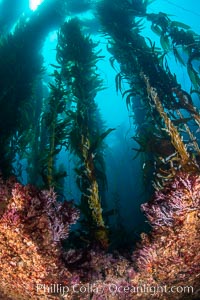
The Kelp Forest of San Clemente Island, California. A kelp forest. Giant kelp grows rapidly, up to 2' per day, from the rocky reef on the ocean bottom to which it is anchored, toward the ocean surface where it spreads to form a thick canopy. Myriad species of fishes, mammals and invertebrates form a rich community in the kelp forest. Lush forests of kelp are found throughout California's Southern Channel Islands.
Species: Giant kelp, Macrocystis pyrifera
Location: San Clemente Island, California
Image ID: 34612
Species: Giant kelp, Macrocystis pyrifera
Location: San Clemente Island, California
Image ID: 34612
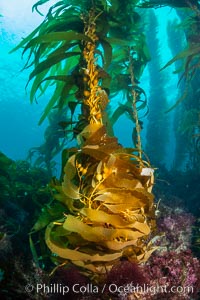
The Kelp Forest of San Clemente Island, California. A kelp forest. Giant kelp grows rapidly, up to 2' per day, from the rocky reef on the ocean bottom to which it is anchored, toward the ocean surface where it spreads to form a thick canopy. Myriad species of fishes, mammals and invertebrates form a rich community in the kelp forest. Lush forests of kelp are found throughout California's Southern Channel Islands.
Species: Giant kelp, Macrocystis pyrifera
Location: San Clemente Island, California
Image ID: 34613
Species: Giant kelp, Macrocystis pyrifera
Location: San Clemente Island, California
Image ID: 34613
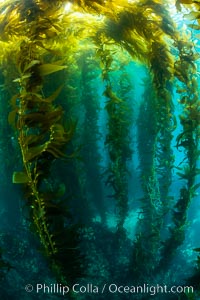
The Kelp Forest of San Clemente Island, California. A kelp forest. Giant kelp grows rapidly, up to 2' per day, from the rocky reef on the ocean bottom to which it is anchored, toward the ocean surface where it spreads to form a thick canopy. Myriad species of fishes, mammals and invertebrates form a rich community in the kelp forest. Lush forests of kelp are found throughout California's Southern Channel Islands.
Species: Giant kelp, Macrocystis pyrifera
Location: San Clemente Island, California
Image ID: 34614
Species: Giant kelp, Macrocystis pyrifera
Location: San Clemente Island, California
Image ID: 34614
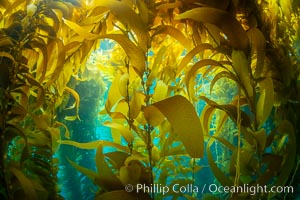
The Kelp Forest of San Clemente Island, California. A kelp forest. Giant kelp grows rapidly, up to 2' per day, from the rocky reef on the ocean bottom to which it is anchored, toward the ocean surface where it spreads to form a thick canopy. Myriad species of fishes, mammals and invertebrates form a rich community in the kelp forest. Lush forests of kelp are found throughout California's Southern Channel Islands.
Species: Giant kelp, Macrocystis pyrifera
Location: San Clemente Island, California
Image ID: 34615
Species: Giant kelp, Macrocystis pyrifera
Location: San Clemente Island, California
Image ID: 34615
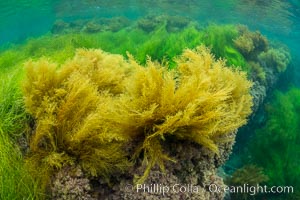
Stephanocystis dioica (yellow) and surfgrass (green), shallow water, San Clemente Island.
Species: Surfgrass, Phyllospadix, Stephanocystis dioica
Location: San Clemente Island, California
Image ID: 30946
Species: Surfgrass, Phyllospadix, Stephanocystis dioica
Location: San Clemente Island, California
Image ID: 30946
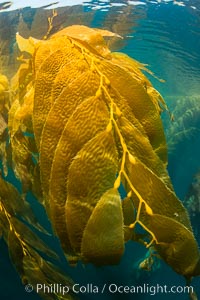
The Kelp Forest offshore of La Jolla, California. A kelp forest. Giant kelp grows rapidly, up to 2' per day, from the rocky reef on the ocean bottom to which it is anchored, toward the ocean surface where it spreads to form a thick canopy. Myriad species of fishes, mammals and invertebrates form a rich community in the kelp forest. Lush forests of kelp are found throughout California's Southern Channel Islands.
Species: Giant kelp, Macrocystis pyrifera
Location: La Jolla, California
Image ID: 30989
Species: Giant kelp, Macrocystis pyrifera
Location: La Jolla, California
Image ID: 30989
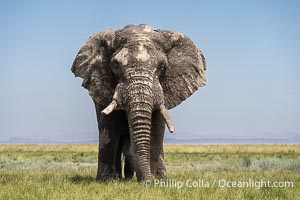
Solitary Adult African Elephant, grazing in field of grass, Amboseli National Park.
Species: African elephant, Loxodonta africana
Location: Amboseli National Park, Kenya
Image ID: 39561
Species: African elephant, Loxodonta africana
Location: Amboseli National Park, Kenya
Image ID: 39561
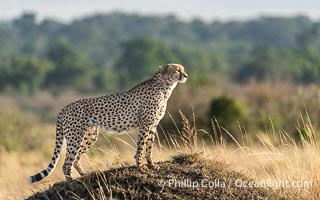
Cheetah in tall grass in the Masai Mara, Acinonyx jubatus, Kenya.
Species: Cheetah, Acinonyx jubatus
Location: Maasai Mara National Reserve, Kenya
Image ID: 39626
Species: Cheetah, Acinonyx jubatus
Location: Maasai Mara National Reserve, Kenya
Image ID: 39626
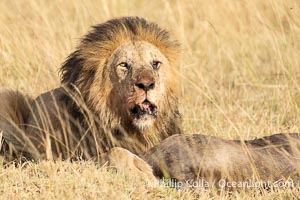
Male Lion with Fresh Kill in Tall Grass, Masai Mara, Kenya.
Species: African lion, Panthera leo
Location: Maasai Mara National Reserve, Kenya
Image ID: 39633
Species: African lion, Panthera leo
Location: Maasai Mara National Reserve, Kenya
Image ID: 39633
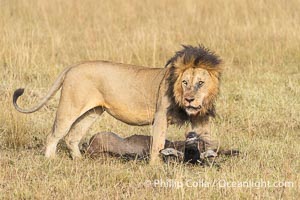
Male Lion with Fresh Kill in Tall Grass, Masai Mara, Kenya.
Species: African lion, Panthera leo
Location: Maasai Mara National Reserve, Kenya
Image ID: 39634
Species: African lion, Panthera leo
Location: Maasai Mara National Reserve, Kenya
Image ID: 39634
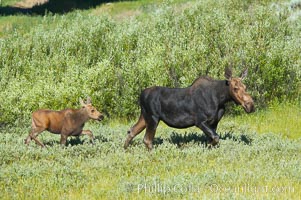
Mother and calf moose wade through meadow grass near Christian Creek.
Species: Moose, Alces alces
Location: Christian Creek, Grand Teton National Park, Wyoming
Image ID: 13037
Species: Moose, Alces alces
Location: Christian Creek, Grand Teton National Park, Wyoming
Image ID: 13037
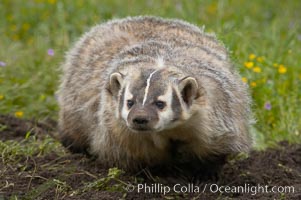
American badger. Badgers are found primarily in the great plains region of North America. Badgers prefer to live in dry, open grasslands, fields, and pastures.
Species: American badger, Taxidea taxus
Image ID: 15947
Species: American badger, Taxidea taxus
Image ID: 15947
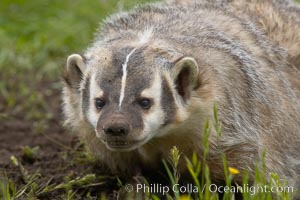
American badger. Badgers are found primarily in the great plains region of North America. Badgers prefer to live in dry, open grasslands, fields, and pastures.
Species: American badger, Taxidea taxus
Image ID: 15948
Species: American badger, Taxidea taxus
Image ID: 15948
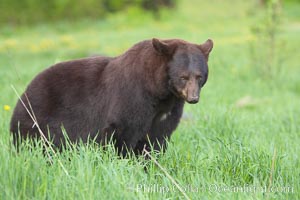
Black bear portrait sitting in long grass. This bear still has its thick, full winter coat, which will be shed soon with the approach of summer. Black bears are omnivores and will find several foods to their liking in meadows, including grasses, herbs, fruits, and insects.
Species: American black bear, Ursus americanus
Location: Orr, Minnesota
Image ID: 18763
Species: American black bear, Ursus americanus
Location: Orr, Minnesota
Image ID: 18763
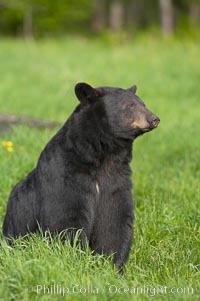
Black bear portrait sitting in long grass. This bear still has its thick, full winter coat, which will be shed soon with the approach of summer. Black bears are omnivores and will find several foods to their liking in meadows, including grasses, herbs, fruits, and insects.
Species: American black bear, Ursus americanus
Location: Orr, Minnesota
Image ID: 18764
Species: American black bear, Ursus americanus
Location: Orr, Minnesota
Image ID: 18764